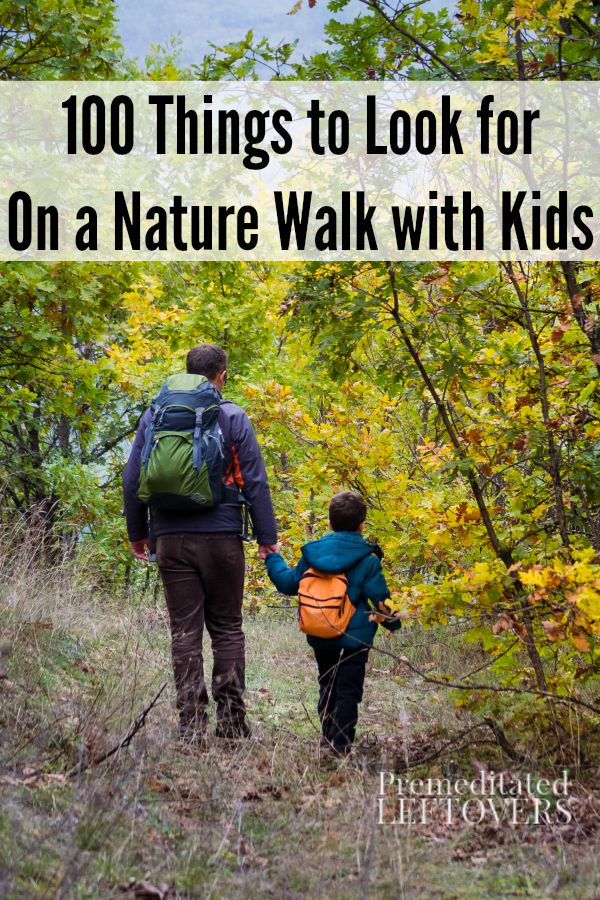Use this list of 100 things to look for on a nature walk with kids to make your family walks more fun

Here are 100 Things to Look for on a Nature Walk to keep you and your kids busy no matter where you head out to explore. From the classic signs that an animal has been in an area, to the source of water that is necessary for life, this list has tons of fun things for you and your kids to watch out for on the trail.
100 Things to Look for on a Nature Walk
- Animal Tracks
- Berries on bushes or trees
- Fruit from trees
- Nuts from trees
- Fallen leaves to determine types of trees in the area
- Moss on logs, rocks and in shady areas
- Local common snakes (wear long pants, boots and never disturb)
- Insects
- Arachnids (spiders)
- Animal homes, holes in the ground or obvious dens (don’t disturb,just observe)
- Natural or man made caves or dwellings
- Creek beds and rivers
- Different types of rocks and minerals
- Rock formations
- Wild flower species
- Trails from humans or animals
- Carcass or remains of animals
- Animal droppings
- Antlers from deer
- Various types of spiderwebs
- Wild turkeys
- Wild hogs
- Different species of birds
- Lizards
- Markings on trees from deer or bears
- Evidence of fire (from wildfire or humans building camp fires)
- Cocoons from moths
- Naturally growing mushrooms
- Butterfly chrysalis
- Ant hills
- Fossils
- Natural water springs
- Trash or litter you can pick up and dispose of properly
- Geocache locations (plan your nature walk around local GPS locations of Geocaches
- Tadpoles in rivers, creeks or pools of water
- Skin that has been shed from snakes
- Fallen branches or limbs that could be used to build shelter
- Different colored leaves
- Algae on water or ponds
- Lily pads on water or ponds
- Fractal items like leaves, spider webs and similar
- Different types of soil along the way
- Beehives
- Bird nests
- Mistletoe (it is parasite in many trees)
- Fallen logs
- Off road vehicle tracks (look for dirt bike, 4 wheeler or other similar off road vehicle tracks)
- Naturally growing herbs
- Different types of grass and ground covering
- Different smells (wood, grass, animal droppings, flowers, mold)
- Different types of tree bark
- Trees that are easy to climb
- A rock with multiple colors
- New or baby trees around older existing trees (signs of healthy soil and a tree that is dropping seeds)
- Different types of seeds from trees and plant life
- Poison Ivy, Poison Oak, or Sumac (you want to avoid, but it is a great way to teach kids what they look like)
- Worms
- Animals or insects that camouflage themselves
- Count the different colors you see along the way
- Look for frogs
- Squirrels nests (where they hoard nuts, berries and other supplies)
- Natural compost (areas where leaves and such are rotting to create rich soil)
- Pine cones
- Something round
- Plants with thorns on them
- Walking sticks (the insect as well as the stick for use to steady yourself while exploring)
- Waterfalls
- Vines to pretend you are Tarzan on (only with adults permission and safety precautions)
- Quartz Crystals
- Money(people often litter or drop change that animals pick up and take back to their nests)
- Eggs (birds, snakes and lizards all lay eggs)
- Snails
- Red clay
- Feathers from birds
- Arrowheads or slate rocks that could be fashioned into arrowheads
- Arrows
- Ferns
- Remnants of shells used in hunting
- Blossoms or buds on a tree or bush
- A tree growing through something like another fallen tree, rock formation or similar
- Ladybugs
- String or twine gathered by birds or discarded by hikers
- Carvings on trees from other walkers or hikers
- Signs of infestations killing plants (dead trees, grass or areas that look like something has killed plant life
- Rocks that are bigger than you are
- Something that is soft and fuzzy
- Seashells (if near the ocean)
- Something straight and narrow
- Fish in ponds, rivers, creeks, lakes or tide pools
- Clover
- Mud puddles (to splash in and have fun)
- Grassy areas for picnics
- Caterpillar
- A leaf with holes in it from insects
- A super large leaf that could provide shelter
- Sand
- Broken glass (litter from other hikers)
- Weather balloons
- Wild onions
- Cactus
This list includes items you would expect to find, a few unusual things, and of course evidence of outside life leaving litter behind. Use this list to create a scavenger hunt for your kids on your next walk!
More Ways to Explore Nature
Tips for Going on a Nature Walk With Kids
Nature Walk Ideas for Kids of Various Ages

Hailey Garrison says
”
This help thanks!”
Rebecca Payne says
I love this nature walk ideas